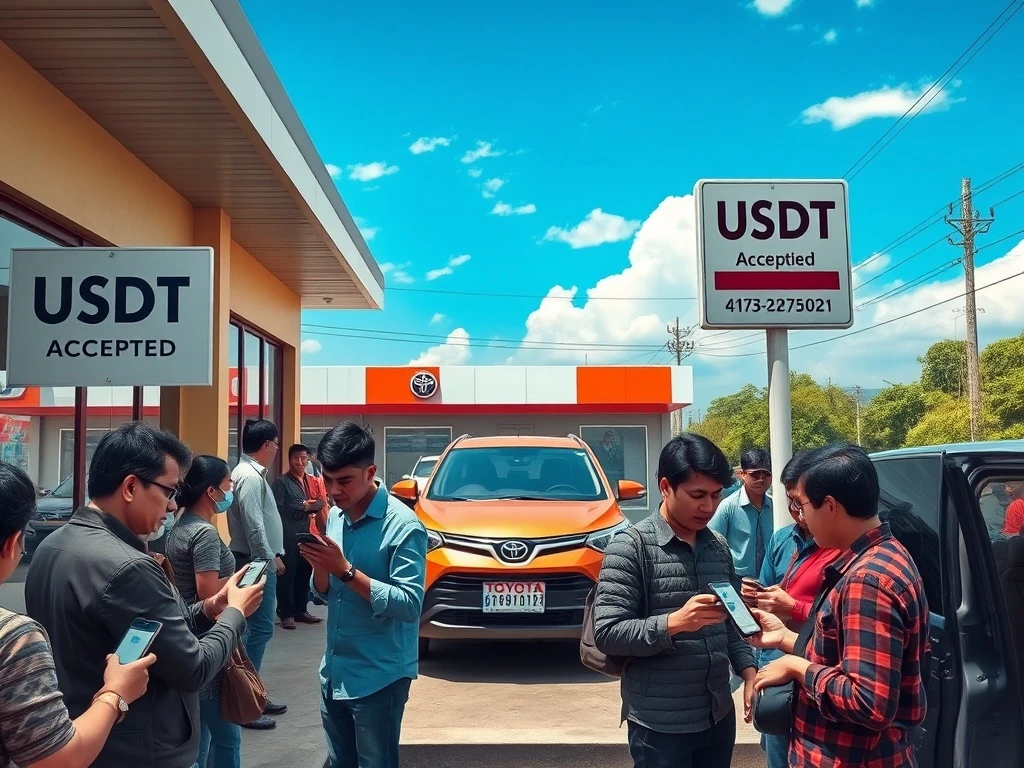Revolutionary Shift: Tether Bolivia Fuels Economic Recovery Amid USD Shortage

A remarkable financial transformation is underway in Bolivia. Major international vehicle manufacturers now accept Tether for payments. This pivotal change addresses the severe US dollar shortage. It signals a new era for Bolivia crypto adoption. For cryptocurrency enthusiasts, this move represents a significant validation. It shows how digital assets can provide practical solutions to real-world economic challenges.
Tether Bolivia: A Game-Changer for Commerce
Three prominent global vehicle manufacturers have embraced Tether (USDT) in Bolivia. Toyota, Yamaha, and BYD now accept the stablecoin. This development offers a critical workaround for the nation’s dwindling US dollar reserves. It marks a substantial leap in the Latin American country’s embrace of digital currencies. Tether CEO Paolo Ardoino confirmed this on Sunday. Crypto security firm BitGo also validated the first Toyota purchase in Bolivia using USDT on Saturday. Dealerships proudly display signs. These signs advertise USDT as an “easy, fast, and safe” payment option for vehicle acquisitions.
BitGo collaborated with Tether and Bolivia Toyota. They ensured smooth transactions and assisted with self-custody solutions. This partnership highlights a growing trend. Businesses are seeking innovative ways to conduct commerce. They navigate complex economic landscapes. This initiative directly addresses the urgent need for stable financial alternatives in Bolivia.
Addressing the USD Shortage Bolivia Faces
Bolivia recently reversed its long-standing crypto ban in June 2024. This change allowed banks to process Bitcoin (BTC) and stablecoin transactions. Previously, Bolivia was one of Latin America’s last crypto holdouts. The country’s economy has struggled with a severe US dollar deficit. Its foreign exchange reserves have plummeted. Data from Trading Economics shows a staggering 98% drop. Reserves fell from $12.7 billion in July 2014 to just $171 million this August. This dramatic decline fuels fears about the Bolivian boliviano’s purchasing power.
Citizens and businesses increasingly seek more stable alternatives. The US dollar was once the preferred option. Now, cryptocurrencies, particularly stablecoins like USDT, fill this void. This shift underscores a desperate need. The country requires reliable mediums of exchange. The economic crisis directly impacts daily life and international trade. Tether provides a lifeline in this challenging environment.
The Rise of Stablecoin Payments in a Crisis
The adoption of Tether extends beyond car dealerships. Bolivian businesses involved in imports increasingly use USDT. Gabriel Campa, TowerBank’s head of digital assets, explained this trend. He spoke to Bitfinex last Tuesday. These businesses acquire stablecoins locally or through offshore accounts. They then convert these stablecoins to US dollars. Finally, they pay overseas suppliers. Many of these imported products are then priced in USDT. This creates a circular stablecoin economy. It keeps trade and operations running smoothly. The local crypto market has seen significant growth. Daily USDT liquidity surged from $20,000 to nearly $1 million in under a year.
This demonstrates the practical utility of stablecoins. They bypass traditional banking bottlenecks. They also mitigate currency devaluation risks. Airports in Bolivia have also started pricing basic items in USDT. This further illustrates the widespread reliance on stablecoins. They help navigate the ongoing currency crisis. Stablecoins offer a stable and efficient medium for transactions. This makes them invaluable for both domestic and international trade.
Expanding Bolivia Crypto Adoption Beyond Retail
Bolivia’s embrace of crypto began earlier this year. In March, state-owned oil and gas firm Yacimientos Petrolíferos Fiscales Bolivianos received government approval. They started accepting crypto for fuel imports. This provided a solution to the country’s deepening US dollar shortages. This move signaled a significant shift in government policy. It acknowledged crypto as a legitimate financial tool. Bolivia’s top bank even praised crypto. It called it a “viable and reliable alternative” to fiat currencies. This statement came during a memorandum signing with El Salvador in late July. The agreement aims to accelerate crypto adoption. Such governmental and institutional acceptance is crucial. It paves the way for broader public and commercial use.
This wider acceptance indicates a strategic pivot. Bolivia is actively seeking innovative financial solutions. The goal is to stabilize its economy. It also aims to foster greater financial inclusion. The collaboration with BitGo further strengthens this ecosystem. It ensures secure and reliable transactions. This builds trust in digital assets. It also encourages more businesses to participate.
Navigating the Bolivia Economic Crisis: Political Will and Blockchain
Bolivia faces a critical juncture. The country will hold a run-off vote on October 19. Rodrigo Paz Pereira’s Christian Democratic Party will face Jorge “Tuto” Quiroga’s Freedom and Democracy alliance. The outcome will significantly impact Bolivia’s economic future. Paz Pereira has proposed implementing blockchain technology. He aims for greater transparency in combating corruption. Quiroga’s stance on crypto remains less clear. The winning party will lead Bolivia after nearly two decades. The Movement for Socialism has governed during this period. Many attribute the current economic crisis to their policies.
The potential for blockchain to enhance transparency is a powerful argument. It resonates deeply in a country grappling with economic instability. Furthermore, the growing use of stablecoins like Tether presents a compelling case. It shows how decentralized finance can offer practical solutions. These solutions address urgent national financial challenges. The integration of crypto into daily commerce highlights its resilience. It also demonstrates its potential to reshape national economies. This is particularly true for those struggling with traditional financial systems.









